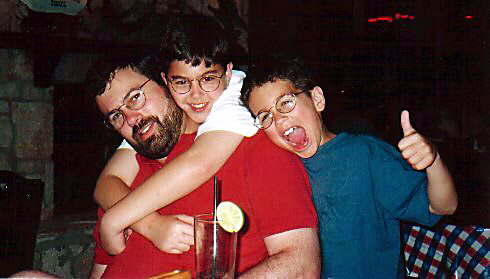The World seems very “Us” versus “Them”... But are we really that different?
The six largest religions in the world are Christianity, Islam, Judaism, Hinduism, Buddhism, and Sikhism.
If you stripped away doctrine, what patterns might emerge in the world’s great sacred texts?
Similarity in Diversity.
We often think about the differences between religions. However, a deep review of their sacred texts shows striking similarities (and may be indications of a more integral “truth”).
Below is a word cloud for each of those religions based on their primary religious text. A word cloud is a visual map of language where the size and boldness of a word reflect its frequency in the text. In this case, the image spotlights the most frequent words across different religious texts (e.g., Jewish Bible, Christian New Testament, Quran, Hindu Vedas, Buddhist Tripitaka, Sikh Guru Granth Sahib).
Each panel highlights high-frequency terms like Lord, God, man, people, Israel, Indra, Agni, Allah, fortunate, Guru, etc., with the most frequently used words appearing larger and bolder. A visualization, like this, makes it easy to identify the recurring themes or focal points of each tradition.
So, here is a closer look at what a word cloud of the world’s religions reveals if we strip away doctrine and focus only on frequency.
teddyterminal via Reddit
On one level, this post explores both the similarities and limits of religious texts via word clouds.
As historian Yuval Harari notes, “Humans think in terms of stories, not statistics.” Those word clouds are the beginnings of narratives that go beyond the numbers. For example, shared words don’t mean shared values. The word ‘love’ in one tradition may imply obedience, while in another it means self-transcendence.
The Power and Pitfalls of Translation
Likewise, translating sacred texts into English makes them more accessible, but can distort meaning and nuance. As an illustration, if you noticed the name “Keith” at the bottom of the Hinduism word cloud, it’s because that was the translator’s name. You might also have seen the word “car” in the Hinduism cloud, that is not an anachronism or prophecy... it is just another old-fashioned word for “chariot”.
It’s also worth acknowledging that this word cloud is from the English translations, so some words that may mean slightly different things in other languages can be all translated to one word in English. For example, it’s very common in Biblical Hebrew to see different words translated into the same English word. Examples include Khata, Avon, and Pesha – three different “ways of committing a wrong” that may all be translated to the same English word.
Distortions like these occur across many texts and cultures. In other words, similarities in word usage do not always reflect shared values. Recognizing this helps us navigate between the boundaries of certainty and uncertainty.
This brings to mind an ancient parable …
The Parable of Perspectives – Lessons from the Elephant
I’ve always loved the parable of the blind men and the elephant. While there are many versions, here’s broadly how it goes:
A group of blind men heard that a strange animal, called an elephant, had been brought to the town, but none of them were aware of its shape and form. Out of curiosity, they said: "We must inspect and know it by touch, of which we are capable". So, they sought it out, and when they found it they groped about it. The first person, whose hand landed on the trunk, said, "This being is like a thick snake". For another one whose hand reached its ear, it seemed like a kind of fan. As for another person, whose hand was upon its leg, said, the elephant is a pillar like a tree-trunk. The blind man who placed his hand upon its side said the elephant, "is a wall". Another who felt its tail, described it as a rope. The last felt its tusk, stating the elephant is that which is hard, smooth and like a spear.
This parable highlights that even when everyone is “blind” to the whole truth, each perspective still holds real insight. Recognizing that partial views are still valuable can drive innovative, integrative thinking.
The blind men and the elephant parable also reminds us of the limitations of individual perspectives and the value of integrating multiple viewpoints. Interestingly, that integration is one of the things large language models are best at ... and helping humans access a perspective of perspectives might be a step towards enlightenment.
Future societies may see it as obvious that synthesizing perspectives (religious, cultural, strategic) can be done by advanced AI at scale, transforming how we resolve complex disputes.
Hope that helps.
Oh, and as a thought experiment ... What would the word cloud of your own guiding beliefs look like?



The Future of Biohacking
Today’s my birthday. I woke up on the right side of the dirt, in America, grateful for the opportunities ahead.
So far, so good.
For me, birthdays also invite a moment to pause and reflect on where I am, where I want to go, and what it’ll take to get there.
On the health front, I’m reminded of a simple truth: A healthy person has a thousand dreams, while an unhealthy one has only one.
Thankfully, I still have many dreams.
We’re lucky to be born late enough in human history that medicine isn’t just about fixing what’s broken—it’s about regeneration and life extension. The real promise isn’t just living longer, but living well longer.
That’s a future worth investing in.
So today, I’m dusting off some notes from a meeting I had years ago—lessons that feel more relevant than ever.
A Chat With The Father of Biohacking
In 2018, I was in Alaska at Steamboat Bay for a CEO retreat. I was spending time with a friend, Dave Asprey, a successful serial entrepreneur, author of several great books, and a thought leader in biohacking. In many ways, he’s the father of modern biohacking.
We recorded a video where Dave did a great job of relating his world to the world of Capitalogix and trading. I share it in part so you can experience his wide range of interests and expertise. It holds up well. I encourage you to watch it.
Via YouTube.
In the video, Dave explains that life evolves through a series of algorithms operating at microscopic levels. Your body and brain are made of tiny parts working like clever little computers. These parts constantly talk to each other, sense what’s happening around them, and change their behavior to keep you alive and thriving.
Dave points out that there are striking similarities between genetics/epigenetics and modern digital algorithms. Markets and businesses make numerous small decisions and adjustments to achieve significant outcomes.
In a sense, Markets and industries function like biological environments where algorithms continuously evolve and adapt.
It helped me reframe my perspective on my business. But it also got me thinking more about my health and how I wanted the next 20 years of my life to look. As a result, I started taking care of my health and paying more attention to preventive care.
Health is the foundation that gives all ambitions a place to stand.
Focusing on the positive is important, but extending your healthy lifespan starts by being honest with yourself and identifying what you and your body struggle with the most.
A doctor friend gave me some advice. He said it doesn’t matter if you’re on top of 9 out of 10 things; it’s the 10th that kills you.
The goal isn’t just to stay alive longer; it’s to live life to its fullest for as long as possible.
I recently joined a fantastic mastermind group called DaVinci 50, run by Lisa and Richard Rossi. It brings together a remarkable collection of medical professionals and entrepreneurs focused on the latest research, treatments, and opportunities in health and longevity.
Another great tool I rely on is Advanced Body Scan. Early detection is crucial, but so is tracking the history of your scans to monitor changes over time. In my opinion, the most valuable scan is always the next one.
Additionally, I utilize a growing list of trackers and biometric devices to monitor my heart rate, along with various apps and tools for mindfulness, breathwork, and journaling. It is essential to recognize that the mind, body, and spirit work together to shape how you live your life.
Where Biohacking Fits In
It’s not surprising that biohacking has become as popular as it has. In a society that encourages (and perhaps even necessitates) an impossible balance between work, responsibilities, and self-care, it makes sense to want to increase efficiency and effectiveness.
Biohacking helps you do more with less. Biohacking is popular because it promises to help you achieve peak performance via the path of least resistance.
Having trouble with sleep, but don’t want to stop using your phone before bed? Wear blue-light blocking glasses.
Not getting enough results at the gym? Work out “smarter,” not harder, by using cryotechnology and intelligent lifting machines.
While biohacking started as tricks like that – nootropics to help your mind, light and sound machines to decrease stress – it’s becoming increasingly tech-centric and augmentation-based.
In Sweden, thousands of Swedes are having microchips inserted under their skin to speed up their daily routines. They use chips to open locked doors, store contact information, and access the train.
The Future of Biohacking
Long-term, it’s likely you’ll see it moving toward exoskeletons, AR/XR experiences, and, unsurprisingly, sex toys. It’s also being used to create artificial organs and counteract memory loss. Companies leading this movement are Neuralink, Biohax International, and Digiwell. While it’s currently being adopted primarily by fast movers and technocrats, it’s pragmatic to think that more widely adopted versions of this will emerge as technology becomes standardized and protections are put in place.
For all the excitement, it’s necessary to remain skeptical and patient. DIY biohacking raises several ethical concerns, particularly regarding data protection and cybersecurity. As a reminder, when it comes to cybersecurity, you, the user, are the biggest weakness.
There’s no stopping this train, but there’s still time to ensure it stays on track.
If you’re looking to get started, here’s an hour-long conversation with Dave Asprey about his favorite optimizations.
Here’s to having a thousand dreams, leveraging the best of today’s medical advances, and investing not just in years added, but quality within those years.
Onwards!
Posted at 05:14 PM in Books, Business, Current Affairs, Food and Drink, Gadgets, Healthy Lifestyle, Ideas, Market Commentary, Personal Development, Religion, Science, Trading, Trading Tools, Web/Tech | Permalink | Comments (0)
Reblog (0)